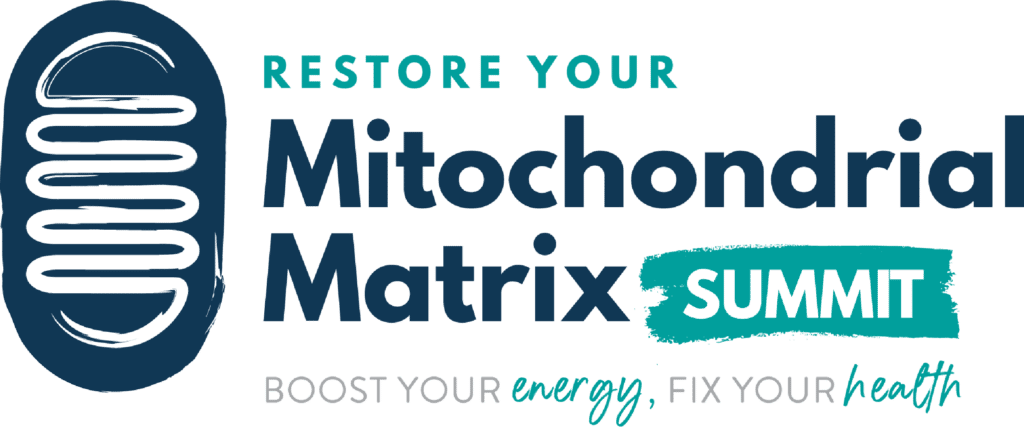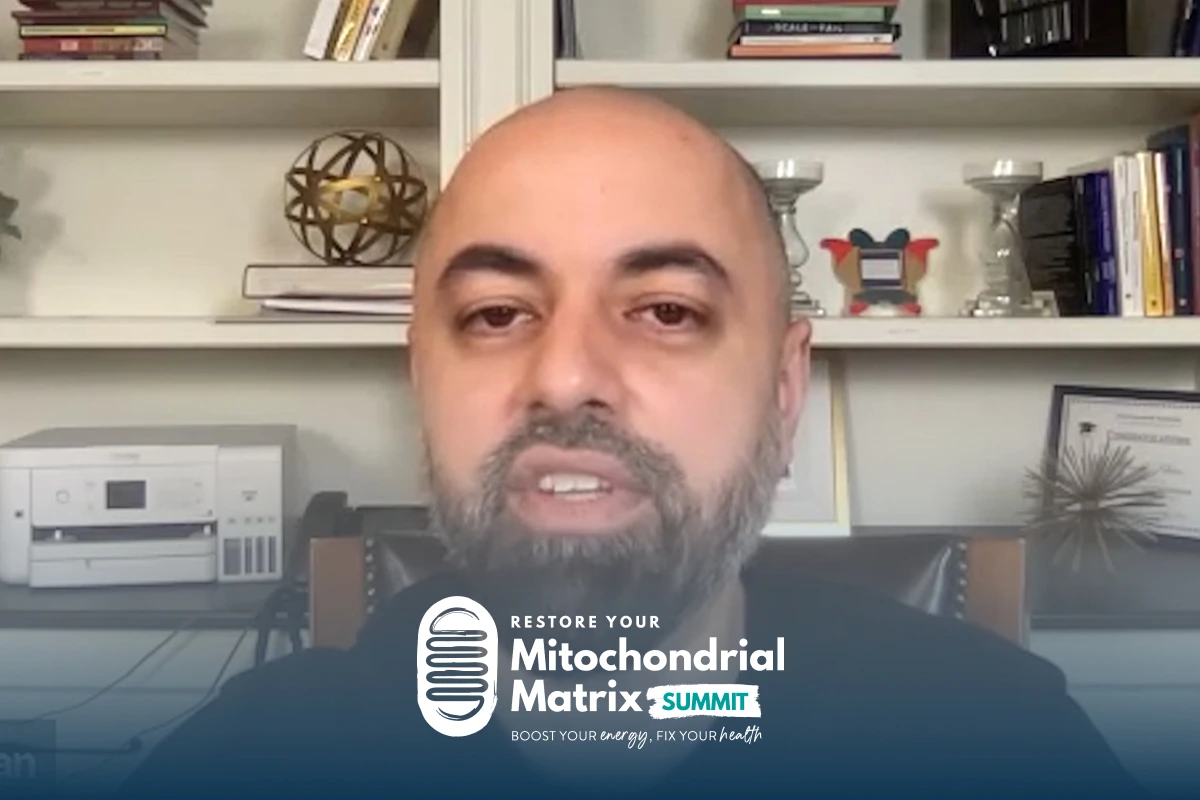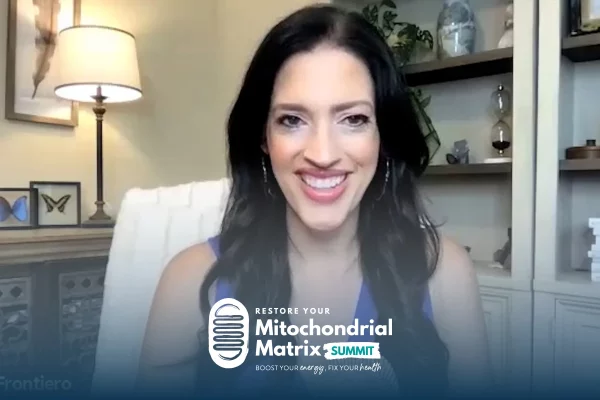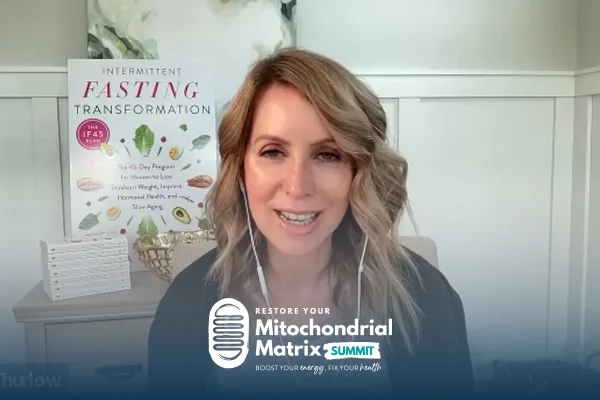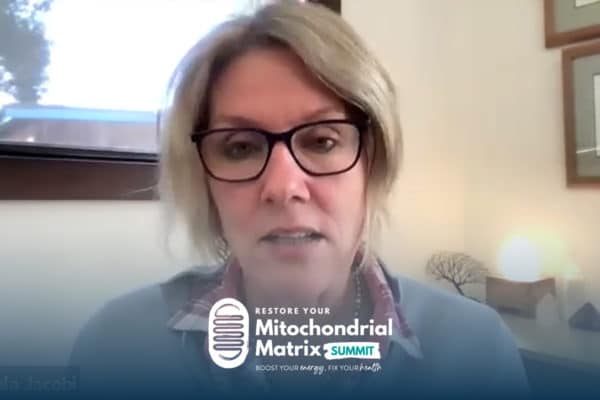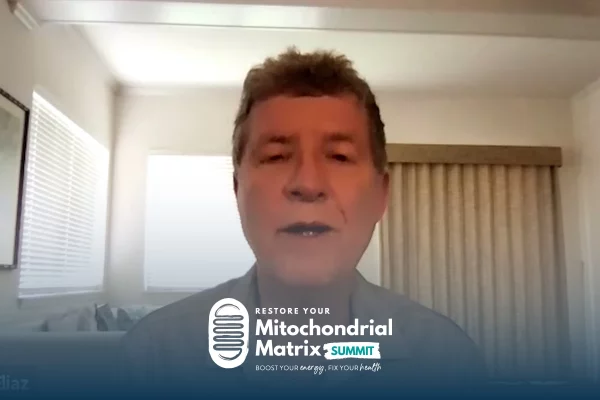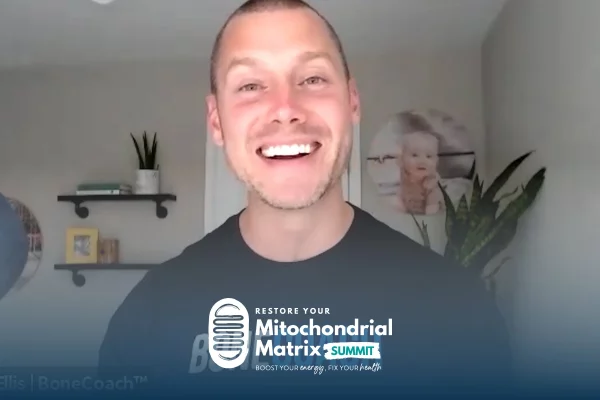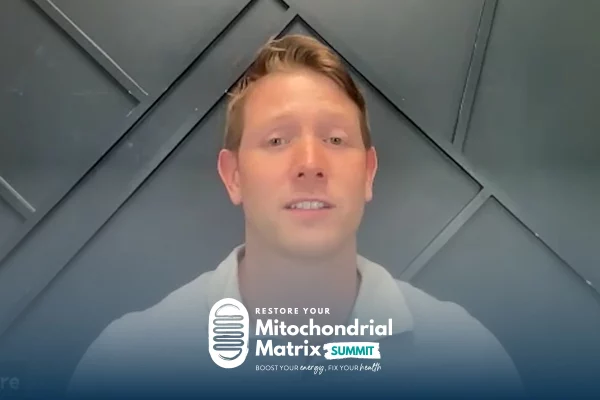Join the discussion below

Laura Frontiero, FNP-BC, has served thousands of patients as a Nurse Practitioner over the last 22 years. Her work in the health industry marries both traditional and functional medicine. Laura’s wellness programs help her high-performing clients boost energy, renew mental focus, feel great in their bodies, and be productive again.... Read More

Kashif Khan is the Chief Executive Officer and Founder of The DNA Company, where personalized medicine is being pioneered through unique insights into the human genome. With the largest study of its kind globally, The DNA Company has developed a functional approach to genomic interpretation overlaying environment, nutrition, and lifestyle... Read More
- Why knowing your genetics helps speed the process of restoring your energy and health.
Related Topics
Cellular Function, Cellular Health, Cellular Health Failure, Chronic Disease, Chronic Disease Management, Chronic Disease Prevention, Core Detox Processes, Detox, Dna, Environmental Toxins, Epigenetics, Functional Genomics, Genes, Genetic Code, Genetic Research, Genetics, Genome, Healthcare, Hormone Health, Inflammatory Load, Mitochondria, Nutrition, Personalized Medicine, Reverse Chronic Disease, Sick Care, Snps, Switches, Well Care, Western MedicineLaura Frontiero, FNP-BC
Welcome back. You’re watching the “Restore your Mitochondrial Matrix Summit”. I’m your host Laura Frontiero, and I’m bringing you experts with fresh ideas and proven methods to help you boost your energy and fix your health so you can build the life you love. And today my special guest is Kashif Khan. Hi, Kashif. Welcome to the summit.
Kashif Khan
Hey, how are you doing? Pleasure to be here.
Laura Frontiero, FNP-BC
Great, great. I’m so glad to have you here. You have such an interesting thing that you do and I can’t wait to jump into this. Kashif, you are the CEO and founder of The DNA Company, and this is where personalized medicine is being pioneered through the human genome. And as I understand it, you actually dove into the field of functional genomics with The DNA Company and noticed that your own genes had a particular sensitivity to pollutants, which got you thinking of your own family’s genetic pathways and what led to their challenges and the opportunities to reverse chronic disease. Is that right?
Kashif Khan
Yeah. I mean, I grew up around illness. I actually grew up in poverty because my dad was so sick he couldn’t work. He had chronic diseases from the time I could remember, and I just thought that that was normal. He’d had cardiac disease. Then my grandmother was sick, my uncles were addicts and depressed, so just a whole mess around me, right.
Laura Frontiero, FNP-BC
Wow! So this is fascinating that this is what got you into DNA.
Kashif Khan
Yeah, led me there. I mean, I didn’t come from the industry. I didn’t come from the science side, I was running a PR and marketing company in Toronto and I helped startup companies grow, and I just got sick myself. And I learned from my own journey of being failed by medicine and only ever treating symptoms and not understanding why. My biggest question is why? Why does this stuff happen? Why do we get sick? When I wasn’t born sick, I didn’t have these problems last week, now, all of a sudden I have, and what changed? And it was my genome that sort of helped me unpack and understand root causes. And I’m not talking about genetic conditions like sickle cell syndrome, like diving deep into cellular their function and truly understand what’s going on, and I was able to resolve everything.
Laura Frontiero, FNP-BC
That’s so incredible. So today we’re really gonna get into why do we age at different rates? We’re gonna talk about how genes drive cellular function. We’re gonna talk about the science of genetics and longevity. So why don’t you start by really telling us the story of how The DNA company was formed? What happened there?
Kashif Khan
Yeah, sure. So there’s a brilliant scientist in Toronto named Mansoor Mohammed who was sitting in a clinic dealing with sort of Canada’s wealthiest people at the genomic level, helping them solve their problems. A lot of it was wrapped around breast cancer at the time. And so I, like I said, had issues myself, I had, you know, skin issues, migraine issues, which was probably the worst of it. Digestive issues, even mental health issues, sliding in and out of depression. And all of this stuff kind of seemed like it didn’t add up like why all the sudden? I’ve been healthy my whole life. Why all of a sudden? What’s going wrong? And so I learned through him and another friend named Bryce, who was a functional medicine practitioner, that what I was doing to ask, sort of, clinicians, doctors, like how do I deal with this?
Which was a pill for this, a scan for this. So, you know, literally an MRI to figure out why you get migraines. This type of behavior was only ever masking the symptom. And so when I discovered in my genome that I was literally, forget about SNPs or variations that you hear about like mutations that people talk about, I was entirely missing very specific genes that instructed core detox processes. So that innate cellular health, like the beautiful thing that you just said about, you know, the energy that you can drive from having healthy cells, like it’s kind of the message I got from you. That’s what I was missing.
My cells were under heavy, heavy load and pressure of all the environmental toxins, the food I was eating, everything that I was doing wrong ’cause I didn’t know what the right choices for me were. Once I unpacked that and understood how I was wired, what to do about these genes that I was missing, what to do about other genes that were overcompensating, all the symptoms started to go away. Eczema, psoriasis, migraines, all these conditions I had, which were just the outward, you know, last step of this cellular health failure I was experiencing, right. Once I started to unwrap all that onion and get to the root of this hub that drove everything, everything went away, and I haven’t had these things in years, right.
So from there I started to unpack, “Well, why was my dad so sick? “Why was my mom so sick?” I just grew up watching them in all this, and I started to learn about female hormone health and how it’s so very deterministic versus the gray area that we think it is. “And you’re supposed to have problems, it’s your hormones.” That’s kind of what women hear. And then my, yeah, and my dad with heart disease and with diabetes, and I started to learn that that doesn’t have to happen if you understand why it happens. And that’s when I literally walked away from my business and said, “I have to do this.” And I funded it and took a full time focus, and we built to what it is today.
Laura Frontiero, FNP-BC
That’s incredible. I mean, really it’s so remarkable when it was your own health and your family’s health and the people you love, and the people around you, and this huge aha that, “Wait a minute, “it’s not the way Western medicine is telling us. “It’s not the way we’ve been instructed. “There’s actually more to it, “and we can solve our own problems “if we know more about our DNA.’ That’s what I’m hearing you say.
Kashif Khan
Yeah. In Western medicine, you know, when it comes to acute, like, I feel very blessed to be in Canada where I can go to a hospital if I break my arm or if I have a terminal condition, they will help me. But why did I get that terminal condition? I won’t get that answer. If it’s not genetic in nature, meaning there’s a switch that was turned on or off that directly equals the problem. There’s certain diseases that that’s true and you now have to manage it and you have to find a therapeutic that will help you sort of maintain good health while you have that condition. But that’s a very small slice of healthcare problems, 90%. According to the CDC, the Center for Disease Control says that 90% of America’s $4 trillion healthcare budget is spent on chronic disease. You are not born with any of those problems.
The nature of being chronic, meaning that you took 7, 10, 15 years of wrong choices, misaligned to your genomics to eventually cause that level of inflammatory load that a disease expressed. Which disease depends cellularly where you’re doing wrong, or it was driven by hormones, if it was driven by toxins, you can try to figure out which disease? But you didn’t have it, it wasn’t innate, you weren’t born with diabetes. It’s something that happens over time for making poor choices. So once I understood that, that’s when I understood that not that Western medicine was failing, but it was taking that acute toolkit and applying it to chronic disease. When we have to look at chronic disease in a very different way, we have to ask why? And then not treat it, but prevent it or reverse it, which you can do.
Laura Frontiero, FNP-BC
Yeah. Preventing and reversing the name of the game. And I know that’s why so many people here are watching because they haven’t fixed their health yet by being in a model of care that’s just sick care instead of well care. So a moment ago you mentioned a switch and I wanna get more into that because I think that that’s a really good way to wrap your mind around what’s happening with genetics. And I think this is a segue into that. So how much do we really need to know about epigenetics versus genetics? And can you tell us about that switch while you talk about this?
Kashif Khan
Sure. So what is your DNA? Every one of your 57 trillion cells has an instruction manual inside it, and that is your DNA. It’s a genetic code that’s literally instructing your cells what to do. Every cell accesses a different part of that instruction manual. That we don’t understand yet. How does each cell, the heart cell, the liver cell know what part of the book to read, and then what to do. We we’re not quite there yet in science, but we do know how they interact, the cells and the instructions. So in that code, you have 22,000 genes that make up your book. Sometimes there’s a spelling mistake, right? Each gene is thousands of letters long, and there’s 22,000 of them. Certain genes we’ve learned will have a T instead of a C, and it’s kind of like you’re reading a book and there could be T-H-E-R-E or T-H-E-I-R, two different meanings. If you’re reading the book, you kind of still understand what it’s saying, but you’ll catch the mistake.
All of a sudden the function is different, the instruction is different, right. What you meant to say is now different because of that one letter. So that’s the switch. And that’s where most sort of pharma research, genetic research is focused. Let’s find what are called the SNPs, S-N-Ps, these switches where the spelling mistake is there, and now this gene does something different. And if we can study 1,000 Alzheimer’s patients, we might find a gene that tells you, you have an 80% chance of Alzheimer’s. All that does is give you anxiety that you’re gonna have the Alzheimer’s for the next 30 years waiting to see. It doesn’t tell you why or what to do about it, all we found is this switch, right.
Now for genetic conditions, it literally turns the condition on, meaning something like sickle cell syndrome. You are born with it. There was a genetic switch, this letter that was spelled wrong turned that condition on, you have it from birth and you have to live with it. Down syndrome: there’s a switch that was turned on or off, you now have it, you have to live with it. So what we are talking about chronic disease, which is the majority of what people deal with, there’s no switch for that. What there is is switches or instructions that are pointing to poor cellular function. And if you start to understand which cellular function, you now know, what you pointed out, which epigenetic choices are gonna take you from, I was born with bad genes to I’m sick. And I’ll give you an example of that, and using my father’s example, I mentioned his cardiovascular disease, right.
So when we look at heart disease, it’s usually not in the heart, it’s usually in the arteries around the heart, right. The calcification, the blockage, the cholesterol build up, eventually it gets so bad that the blood doesn’t flow to the heart, heart attack happens, but the heart was healthy up until that moment usually. So why this happens is, and now there’s some geneticists out there trying to find the heart attack gene, which is not the way the body works, What’s actually going on is we know in biochemistry that the root of the cholesterolemia, the calcification, the blockage is in inflammation; the arteries, which is where the disease happens, get inflamed. Very specifically the inner lining that’s called the endothelial, that gets inflamed. Why the inner lining and not the outer? Because the inner lining is where your blood flows through and touches, and sometimes your blood is delivering toxins, heavy metals, things that this cellular structure was never designed to deal with.
Laura Frontiero, FNP-BC
Right.
Kashif Khan
Right. Especially given the way we live today, the way we eat, what we have to breath, the chemicals we use to clean our house and make our garden so beautiful. When we’re bringing those into our system, some of us, like myself, like my father, are missing the genetic code to clear those. So there’s this police force that’s supposed to be in your blood, directed through the GST family of genes. There’s several genes under the GST family. It’s possible to not only have that SNP or spelling mistake, there’s something called a copy number variation. The whole page is torn out of your manual, you don’t even have the gene. There’s no error to look for ’cause you don’t even have the gene.
So imagine you’re reading a book and there’s a page missing versus a spelling mistake, which is what most genetic testing companies look for. So now if that’s the case and you have this missing code, and you’re working in an office building, and there’s chemicals to spray and clean the washrooms and you’re walking downtown and there’s pollution, and all of a sudden your body cannot clear that stuff. So it’s free-flowing in the blood causing and wreaking havoc to this weak, which is why, by the way, there’s different quality versions of this hardware, your genes determine, are you resilient stainless steel or more paper thin, which is possible. If you have the paper thin version and you’re missing detox genes like me and you’re going in the wrong environment, bringing them in, that’s the epigenetic part, you’re gonna cause inflammation here. The body will then use cholesterol as a hormone to reduce the inflammation.
That’s why the cholesterol is deployed and sent there. It’s not a disease, it’s a repair mechanism, it’s a hormone sent to repair inflamed tissue. It’s when that cholesterol meets the toxicity or there’s certain genes that instruct the transport of the cholesterol, which you may have the bad version of, that all of a sudden it starts to build up. And then eventually doctor says, “Oh, there’s a biomarker that looks off, “your cholesterol numbers are high, “and that’s the root cause of heart disease.” But what we’re saying is heart disease isn’t a disease, arterial disease is a disease, and it’s rooted in inflammation caused by toxic insults.
There’s multiple combinations of why you could get there. I don’t detox. I have bad quality hardware. I don’t deal with inflammation well, which is methylation, suppressing the inflammation. There’s many reasons why it could happen, but they all point to the same thing that it was the inflammation here was the start, the beginnings of the disease, that was the sort of impetus. What we’re now treating is 15 years down the road of a trigger of, your cholesterol numbers are up, start taking Lipitor.
Laura Frontiero, FNP-BC
Yeah. Kashif, if I can still remember working in, you know, I worked in Western medicine clinics for 20 years prescribing cholesterol drugs before. . And I can remember somewhere in the early 2000s, the concept of inflammation is a problem in the vessels. And I remember the studies that were coming out about statins and “Oh, maybe they’re reducing inflammation “that maybe that’s why they’re working.” Anyways, I’m really glad you’re talking about this. And the thing that I would love to highlight is something that you said, and I wanna make sure the audience catches this because it’s so central, I think, in functional medicine and the type of practice that I now have which is, toxins cause inflammation, heart disease, cancer. I mean, the problem is a toxin problem. And this is, if you’re a functional medicine practitioner, because most people watching this summit are gonna be savvy about functional medicine or naturopathic medicine or some alternative, which I even hate to say alternative, but some other form of medicine, other than Western traditional medicine. But if your practitioner is not looking at toxins as a source cause of problems, we have a problem.
Kashif Khan
Big problem. Yeah. You ask the question like when you look at it from that perspective, like what you just laid out, the evidence is right in front of us. You look at things like autism, where a couple generations ago it was one in 10,000 children, then a generation ago it was one in 500, now it’s one in 58, right. The kids haven’t changed. Our DNA of today is the same for the past 250,000 years. The genetics haven’t changed, we’re the same people, same type of structure. Yeah. We’re all a little different, but the overall manual is the same. It’s a 1/4-million-year-old manual. Why all the sudden did we go from, autism didn’t even exist five generations ago till it’s one in 10,000, it’s now one in 58. What changes our environment?
The exposure to chemicals, the food that we eat that’s laced in pesticides, even something as simple as a natural flavor, which seems is simple. The processing required, the heavy metals used, 75 to 100 chemicals used to take that natural flavor, which was from a natural source, it came from a plant or an animal, that’s why it’s called natural. But to get it into your food requires literally 75 to 100 chemicals. You’re also ingesting that, but those are not required to be listed, ’cause they’re not ingredients, right, those are processing chemicals to get the ingredient into your food. And you wonder why all of a sudden, so much chronic disease, so prevalent, starting at earlier ages, kids aren’t doing well, childhood obesity, all this stuff we haven’t changed as people, our exposure has changed. And it largely has to do with the environmental toxins and the toxins in our food.
Laura Frontiero, FNP-BC
Absolutely. People, our genetics, which we’re talking about right now. It doesn’t change that quickly. It takes thousands of years of evolution. But what has rapidly occurred is the change in the industrial revolution and the amount of chemicals that we do use. And something else I wanna highlight, Kashif, that you just said and make sure everybody gets it. Natural flavoring is a code word for chemicals. Anytime I pick something up and see natural flavoring, it goes right back on the shelf. Become a label reader, natural flavoring is, it’s actually criminal that it’s called natural flavoring because we think-
Kashif Khan
Oh, it’s horrible.
Laura Frontiero, FNP-BC
It makes you feel safe. And it’s really unfortunate, it’s a marketing gimmick. So thank you for unpacking all of this. I’d love to know, when we’re tying together genetics with mitochondrial health, since we’re all about fixing mitochondria, little powerhouses of engines of our cells and boosting energy. So talk a little bit about how genetics is tied to our mitochondria.
Kashif Khan
Yeah. So there’s like the straightforward, how is it tied? And then we can spend another two hours on, you know, all the different ways in which your body is affected by your genes and your mitochondria. So the basics of it is that, like you said, your mitochondria stores your powerhouse, it’s where the ATP and energy is produced. The process of creating energy, which all your cells do is, let’s take in some oxygen, let’s take in some nutrition and convert that to energy. So these are the source, this is the wood that you’re burning to create that energy. But anytime you burn any kind of fuel, there’s always a byproduct, there’s always smoke. So just like your fireplace, when you’re burning those wood logs, the soot has to go somewhere. Your cells, there’s a gene called SOD2 which determines how well you deal with antioxidation.
Remember taking in oxygen creates oxidants. So the irony is the thing that gives you life is slowly aging you and killing you, right. If you don’t have a good relationship and don’t know how you deal with this stuff. So if you are that person that has a suboptimal version of the SOD2 gene and you’re running on the treadmill, you’re doing high intensity training, you’re not sleeping properly, too much stress, and that oxidative stress load is high. Well then you’re burning all this fuel to create energy to not be able to deal with the soot. So it’s like your fireplace doesn’t have a chimney and it’s piling up on the cells. And this is why you look at, kind of, you know, marathon runners that are, sort of, older, and there’s a few that look amazing, they’ve been running all their lives, heart health is amazing. But for the most part they’re all like haggardly wrinkled and white hair, they’re thin, there’s no fat on them, but they look like they just like a candle melted, right, I don’t know how else to explain it, because they’ve aged themselves so much from that oxidative stress load.
So the cells are unraveling, the hair’s unraveling, inside they can’t feel it, but the amount of inflammation they’ve caused themselves. So this is where for the most part, we are not wired to do the one-size-fits-all recommendations. Heart’s not good, go fun on a treadmill. Well that might actually make your heart worse, ’cause you’re gonna increase inflammation, you’re gonna increase free radical activity in the blood for which this bad endothelial, that was a source anyway, was the toxins you were sending here that caused the inflammation. For some people, great, there’re some people that have the optimal version of that gene and they do really well. But for the most part, no. Then you look at mitochondria as not just an energy production, sort of, powerhouse, like you described it, also a signaling system, right?
So it’s that communication system. You know, I touch my head, and instantly every single cell in my body knows exactly what happened, instantaneously. We have no human capability of communicating at this level, you know, 57 trillion individual cells instantaneously know what just happened. That communication both external and internal is, the mitochondria is highly implicit in that. So when we look at the genetics of, you know, female hormone health, and we look at the genetics of oxidation, glutathionylation, methylation, all these loads and we start to see that it’s not just energy production, it’s not just oxidation, but overall biochemical function starts to slip because that communication gets blocked. Imagine if this is your, you have 57 trillion cellular phones that are talking to each other and all of a sudden they’re trying to get through the smoke and all this other stuff, you know. Sorry, if I could just turn that off. Sorry. Then all of a sudden you have these failures and you start to see that other biochemical processes in the body start to fall apart and you can’t find the root cause, like what’s going on? Well, there’s a heavy, heavy load on your mitochondria, everything’s struggling.
Laura Frontiero, FNP-BC
Amazing. I’m going back to what you said like three minutes ago. I just got the biggest smile because I knew there was a good reason for me not to be a marathon runner. I don’t wanna hate.
Kashif Khan
That’s actually, the interesting thing is, anytime we sit with someone for like a clinical review and we tell them that, they know it already, they say, “I know it, I hate running. “I hate cardiovascular exercise.”
Laura Frontiero, FNP-BC
Hate it.
Kashif Khan
They feel it because you can’t recover. The next day you feel horrible. But some people don’t.
Laura Frontiero, FNP-BC
I bet I have that gene ’cause I hate it. And everybody goes, “No, you can build yourself up to it. “You can do it.” I’m like, “You don’t understand my entire life, “I can remember in high school having to run in PE class, “having to run a mile. “And I am not a natural athlete. “It is literally torture for me.” And it’s not ’cause I don’t want to. It’s not. I’ve just always felt lousy. So I can’t wait to run genetics and find out.
Kashif Khan
And I would tell you from our research, there’s more people that are suboptimal than optimal, we don’t find that many people. That we as humans, it wasn’t normal activity, that we didn’t run around and put ourselves under these high cardiovascular. We lifted heavy things. We still exercised, but it was more like moving, lifting, pushing.
Laura Frontiero, FNP-BC
And short term, right?
Kashif Khan
Yes.
Laura Frontiero, FNP-BC
Not prolonged, great. Oh, I’m so glad to learn that. This is why I’m gonna stay youthful forever because I’m not gonna, I’m not gonna melt off my…
Kashif Khan
Yeah.
Laura Frontiero, FNP-BC
I’m not gonna age and melt away.
Kashif Khan
Yeah.
Laura Frontiero, FNP-BC
Oh my gosh, I love it. This is so fascinating. Thank you for tying in the mitochondrial piece, it’s so important. And I think, you know, you’re the first person that’s really talking about the communication, the mitochondrial piece of being a network of communication that happens instantaneously.
Kashif Khan
Yeah. It’s really cool. I mean, your mitochondria is constantly, sort of, looking outwardly to understand what’s happening in the environment around you. So your body gets signaled from a few things, from emotion, like what are you feeling? So your body knows what to prepare for. Temperature, volume, you’re responding to all this stuff. In your mitochondria are these little sensors that are understanding what’s going on in the environment around you. And again, going back to toxins, going back to the things that we weren’t meant to cope with interrupts the signal, right. Things like 5G and you hear all the conspiracy theories that there was no COVID, there was 5G that gave everyone all the, you know, I’m not going there, but I’m saying that there’s definitely a disruption in human function because we were not designed to cope with these interruptive signals.
Laura Frontiero, FNP-BC
I have to tell you, I’m not looking forward to upgrading my phone ever because I have the last 4G phone.
Kashif Khan
Yeah.
Laura Frontiero, FNP-BC
Someday it’s gonna die, so I’ll have to get a 5G phone.
Kashif Khan
And that’s the challenge is you have all these EMFs that are out there, that are, like right now, we’re on two devices talking to each other. We’re gonna probably be on TikTok or Instagram at some point tonight scrolling. It is constant.
Laura Frontiero, FNP-BC
It is.
Kashif Khan
And we were not designed for this. So if your mitochondria is supposed to be that source of understanding what’s going around you and you’re constantly sending disruptive signals, right, it’s like being in manic anxiety or in manic anger. It’s not healthy. Your body doesn’t understand the signal.
Laura Frontiero, FNP-BC
It isn’t. And fortunately, we’re gonna have some EMF experts come on this summit as well and talk about that, so make sure that if you’re viewing now that you listen to those interviews, because it’s all tied together everyone, if you aren’t figuring this out already.
Kashif Khan
So important. So important.
Laura Frontiero, FNP-BC
It is. So can you tell us a little bit more about, really I’d like to know what are the biggest areas of impact that you’ve seen in clinical practice by using The DNA Company’s testing? Why do we wanna get this done? Really to speak into that.
Kashif Khan
So when you, I mean, singling us out, I can tell you what we do different and uniquely. We figured, so one thing we did by the way is we understood, and this was from my own personal experience, that genetics itself, it was underwhelming. Unless you had one of those rare genetic conditions we’re talking about. If you had diabetes, breast cancer or fibromyalgia, menopause problems, all the big things that we have to deal with. We weren’t really getting an outcome. It was well, that’s not genetics, that’s lifestyle. That’s what I wanna know, what lifestyle is my genetics telling me to have. So what we ended up doing was, we said that there’s enough data on genes. What do they do? There isn’t this sort of filling the gap of, here’s human biochemistry, we already know how the body works, there’s a cardiovascular system, a hormone system, neurochemicals in the brain. We don’t know how the genes mirror those systems in that context.
Not this gene means this, this gene means this, but here’s a hormone system, now tell me what genes drive all this. We already know how the body works. So that’s what we did. We we studied 7,000 people over three years, one by one, by one, by one, all n-of-1, ’cause we said if you’re gonna create personalized medicine it’s gotta truly be personalized, we’ve gotta get down to the root of each individual’s problem, resolve that, then we have something in the bucket, something learned. And we keep learning, keep learning until we start to see trends and profiles, then also we can help more people on scale ’cause they fit into profiles. So that’s the way we went about the research. And we said that once we identify a suboptimal profile, we then need to ask, not the way you’re told, this gene means you have 80% chance of Alzheimer’s.
What we need to ask is, why did 20% with the exact same profile not get it? What were they doing right? Going back to the very first thing you said of sick care versus well care and healthcare, like true healthcare. Healthcare is, how do I maintain your health? Sick care is how do I treat you when you’re sick? So we understood genetics was looking at stuff wrong. It it was studying the sick only. So they’re only ever coming up with solutions to deal with the sick. Instead of learning the habits of the healthy, the epigenetic habits, environment, nutrition and lifestyle, what did they eat? What chemicals were they exposed to? How did they exercise? How did they sleep? And what, from those, for each condition caused them to go from the 20 to the 80%?
Laura Frontiero, FNP-BC
So let me just rephrase what I think I just heard you say. You looked at people who had genetic SNPs, but they weren’t sick, they were doing great, and you decided to study what set them apart?
Kashif Khan
Yes.
Laura Frontiero, FNP-BC
That is fascinating. Nobody does that.
Kashif Khan
And that’s helpful.
Laura Frontiero, FNP-BC
Nobody does that.
Kashif Khan
Nobody does that. Because if you’re not sick, what is there to study? That’s the belief.
Laura Frontiero, FNP-BC
There’s no money in that, right?
Kashif Khan
The money’s, yeah.
Laura Frontiero, FNP-BC
Like what NIH grant funding are you gonna get to study healthy people? Everything is pharmaceutical driven, don’t even get me started, but okay, carry on.
Kashif Khan
So we had to self-fund it. I had meetings with the Canadian government and I showed them some of our work and they said, “Wow, this is groundbreaking, “but we don’t know how to deal with you.” So we just paid for it. We just funded it ourselves. And we partnered with a bunch of clinics and we worked, ’cause we knew this was what was needed. We needed to not tell people, you got 80% chance of this, 50% chance, we need to tell you, how do you stay healthy. That’s what your genetics should inform you. And just like the cardiovascular example I gave you, it’s not the recommendation you would typically get, “Go run on a treadmill.” That would’ve made the problem worse. The solution is unique. You need to focus on your glutathione pathway, that’s the cause of your heart problem. So we did this in a few areas.
You name a chronic condition, we’ve studied it. But the six areas that we found that are, that if we were to give you your instruction manual for you to become like version 2.0 of yourself, optimal version, here’s the areas you need outside of like clinical representation, like actual clinical problems. And those are diet nutrition, what do I eat? And not only what do I eat? How do I eat? Meaning, how do I even perceive behavioral genomics? Am I an addict? Am I binger? Do I graze in the pantry and I don’t even know I’m doing it? So we study the neurochemicals of the brain and how that applies to how you sort of have a relationship with the food, and then food itself, so macronutrients, micro, should I be on keto diet? Should I be vegan? Do I actually have the gene to metabolize fats and have the enzyme activity to break down beans, lentils, legumes, where I would be a successful vegan. That’s all genetically driven. So diet nutrition. Hormones and fitness. So when it comes to body type, you know, hair, skin, acne problems. I’m going to the gym. Am I meant to be doing a deadlift or running on the treadmill.” All of that is genetically driven. Your success comes from you.
Laura Frontiero, FNP-BC
So what you’re telling me is, you can look at my DNA and you can tell me, you’re fit to be a vegan or you’re not.
Kashif Khan
Yeah.
Laura Frontiero, FNP-BC
You’re fit to be a carnivore or you’re not.
Kashif Khan
Yep. I can tell you that there’s doctors that we’ve talked to where we’ve told them that the root cause of their illness that they can’t figure out is the day they became vegan. And there’s one particular doctor who, that was the one thing she would tell every single patient, become vegan, become vegan, become vegan, become vegan, right. If it works for you, great. It’s the best thing you can do. There’s way more people for whom it doesn’t work, then it works.
Laura Frontiero, FNP-BC
I can’t wait to do this. You know, I feel like crap if I don’t eat meat. If I try to be vegan, it’s ridiculous. Bet I have that too.
Kashif Khan
Yeah. It’s actually a methylation gene and you’re familiar with methylation. Methylation is your anti-inflammatory response.
Laura Frontiero, FNP-BC
So break down methylation for the audience really quick, ’cause I know they hear that word a lot. Let’s make sure that everybody understands what that is.
Kashif Khan
Yeah. So the outcome of methylation is reducing inflammation. What it’s actually doing is, your body sends what’s called a methyl group to bind onto a toxin. So there’s some liver, sorry, some toxins that are cleared through glutathione, where glutathione goes to the liver, gets rid of the toxin. Some are cleared through methylation, which is a methyl group attaches to whatever you’re trying to clear, it becomes water soluble, it kind of converts it, and then you can pee it out or get rid of it. Whereas that thing you weren’t able to clear it. So what the misnomer or the myth is that MTHFR, that gene, is methylation. It’s the most studied gene, but it’s a cascade, there’s a system. It’s not, this gene does this, this gene does this.
No, there’s a whole process and system. So you have to understand from step one till seven, of which there’s seven steps. You could have the best MTHFR, but if everything else sucks, you’re really not doing a good job or flip vice versa. So going back to that, there’s the first gene, the FUT2 it’s called F-U-T-2, also determines how well you produce the enzymes to break down beans and lentils and chickpeas. And this is why so many people have hummus and they get all bloated and they can’t eat their next meal, they’re not even hungry for their next meal because they’re just so bloated, and their stomach is so irritated from not being able to break that stuff down. So that’s a secondary, is hormones, fitness, we talked about diet nutrition, right. Then we look at sleep and this was unintentional by the way, we never set out to say, “Hey, let’s look at the genetics of sleep.” ‘Cause nobody believes that there is even a genetic of sleep. What we learned is that there’s some people that can’t fall asleep, some people that can’t stay asleep, they sleep okay, but then they wake up in the middle of the night. Then there’s some people that sleep through the night, but they wake up feeling like garbage. Like, “I didn’t get quality sleep.”
Those are genetically three very different things. Your internal clock, your circadian rhythm is driven by two genes: one of them is actually called Clock, the Clock gene. Actually, yeah, it regulates your internal rhythm. And then there’s your BDNF or brain derived neurotrophic factor gene, which also works with Clock to set your circadian rhythm. You may not do well there, which means it’s hard to fall asleep with the lights and the Instagram and the blue light and the laptop. And some people, no problem, some people completely screws them up. Serotonin: so when it comes to sleep, most people think I’ll take a melatonin pill, right. If your problem was, “I can’t fall asleep,” great. If your problem is, “I can’t stay asleep,” it’s not gonna help you. The problem with waking up in the middle of the night is your serotonin is produced in your gut while you sleep and is triggered to react when you wake up. Which is meant to be first sunlight.
Which means if your serotonin is dysregulated, your body doesn’t know when hubby pulls on the blanket, when there’s a weird smell, when there’s a noise, “Was that sunlight and I’m supposed to get up, “or was that just something I’m supposed to sleep through?” So that stimulus after the first sleep cycles, we sleep in cycles, right, the first cycle, your body knows I’m asleep. After that, any stimulus, a noise, dog jumps on the bed, whatever. It’s very hard to convince your body that it’s still sleep time, and there’s ways to deal with that. Then there’s environmental things. Like, for example, how many people sleep on a memory foam mattress where every time you roll over your puffing little bubbles of off gassing of chemicals that are in there and you sleep through the night, which is the time you’re supposed to recover, but you’re exposing yourself to so many toxins your body can’t even get to what you’re supposed to do during the day, and you wake up feeling not recovered.
So when we look at the genetics of sleep, we can get very specific about why you can’t sleep, not why people can’t sleep. Then we look at cardiovascular health, so, you know, what we talked about, cholesterolemia, hypertension, diabetes, all the big stuff that fits in that bucket. Why would it happen to you? What can you do to avoid it? And if you’re sick, how do you reverse it? Then we look at innate cellular health, which is what we’re talking about here today, mitochondria. How do you deal with detox, inflammation? How do you maintain vibrant cells? Which is really the hallmark of anti-aging, right. If you want longevity, your cells should be healthy. And the last one, which is probably the biggest report, is mood and behavior. So, because we uniquely met with these 7,000 people that I told you about, we didn’t realize how much we were gonna learn about their behavior and how that’s connected to the genes.
So let me give you an example, using myself, again, as the guinea pig. So when it comes to your pleasure or rewarded response, dopamine is the chemical that allows you to experience that. So when you either eat something tasty or do something good at work, pleasure, reward, dopamine is deployed and you have to bind it, and then you experience that feeling. Then you have to get rid of it to come back to normal. So the gene that determines how well you bind it, DRD2, it actually determines the density of the receptors. How many receptors you have? I have the least possible density. Then there’s a gene called MAO that breaks it down. I have the fastest MAO. Then there’s a gene called COMT, which comes and sweeps away that broken down stuff. I have the fastest COMT. So I feel it way down here, and it lasts that long and it’s done. So there’s three outcomes from me: depression, addiction, and achievement.
Depression, ’cause I just don’t get to feel, and I’m in a context where there is no pleasure. Or addiction ’cause I find something pleasurable and I pursue it and chase it. Or achievement ’cause I feel the reward instead of fueling the pleasure, because it does both. This is driven a lot by context. You know, if I am striving, sorry, struggling because I need cash or somebody needs help, or I need a new car or whatever I’m gonna achieve and work and work and work. But once I get to the point where I feel like I don’t need to work anymore, I might get depressed ’cause I’m gonna stop trying. And if I then get depressed and feel like I need to be happy, I might lean on something else that makes me addicted. The same pathway leads to all three things, it just depends on the context. That’s the epigenetics, what choices did I make? So when it comes to the neurochemicals of the brain, I don’t ever need to meet you or talk to you to know exactly how you behave, your personality, do you procrastinate? Are you irritable? Are you a drama queen? Are you gonna slam the door and walk out of the meeting when I tell you that I forgot to do something? It’s all driven by the neurochemical pathways of your brain, all the neurochemicals are driven by your DNA.
Laura Frontiero, FNP-BC
This is so interesting. You could really, really run this on all, before, like I could just imagine being in the dating scene. Well, before I get serious with you, let me run your , let me run your DNA test.
Kashif Khan
Yeah. I can tell you how many, including by the way earlier today, I can tell you how many sort of family reviews turn into couples counseling. Completely unintentional. But when they start to hear things that make so much sense, like, for example, this afternoon, we were talking to a couple, two CEOs, right, high power, and the husband, because his serotonin is optimal, he’s very macro. He doesn’t really concern himself with details ’cause he’s not responsive to stimuli, so he’s used to thinking at a macro level. The wife, her serotonin is more dysregulated, so she’s much more sensitive to stimuli.
So when they’re trying to make decisions together, he’s like, “Yeah, it’s okay.” She’s like, “No, we haven’t even looked at this “and this and this.” “Like, it doesn’t matter. It’s fine.” And she’s like, “No, but what about this, “and what about this?” He said, “I understand it all and I’m fine.” But she needs to think about the details, the wheels need to spin or she feels like she hasn’t done the same thing that he just finished doing. So we can really start to understand how to help people cope, whether it’s teams, relationships, dealing with your children. If you understand that this is who you are, it’s not just a reaction to something, then you know how to cope with the people around you.
Laura Frontiero, FNP-BC
And some of this stuff can be shifted right? Once you know-
Kashif Khan
Yeah. Shifted in terms of, so for example, the same thing of her being high attention to detail is also when she goes to work, it’s a superpower because she’s seeing all the nuances that her peers don’t see. It’s also, she’s highly irritable and she reacts to everything and people are like, “We’ve got to walk on eggshells around her.” So if you start to understand the context drives the outcome, then you can start to control where “Well, when they say it’s not that bad, “maybe it actually isn’t that bad. “I just feel it a little bit more.” And you can start to come at people and sort of meet them where they’re at.
Laura Frontiero, FNP-BC
So good.
Kashif Khan
Yeah.
Laura Frontiero, FNP-BC
I think of all the personality matrix, tests that are out there trying to figure out, are you analytical? Are you controlling? Are you promoting? Are you supporting? Are you, or Enneagram or, if I’m saying that right, or all these different ones, they just need their DNA test.
Kashif Khan
Yeah. Yeah, you don’t need to guess, it’s wired into your brain, in the chemicals. There’s a gene called ADRA2B that drives your noradrenaline response, so your literal PTSD response. So there’s some people, you remember the Rwandan genocide that happened? I think it was called the Hutus and Tutsis, these two tribes that were killing each other, like a massacre. Scientists went there to try and understand why the second the war was over, these are people that were chopping each other’s arms off at the elbows on a regular basis, they were right next to each other in the market like it never happened, best friends again. Because they had the optimal version of the ADRA2B gene, which means they actually had difficulty and experienced PTSD and trauma.
Laura Frontiero, FNP-BC
Wow.
Kashif Khan
They can’t imprint negative stimuli.
Laura Frontiero, FNP-BC
Oh, that’s fascinating. We could talk for hours on this. Kashif warned me when we started this talk, we could talk for a really long time. I mean, I have so many questions. I’d like to know what the DNA is of serial killers, right, like what’s happening there? What’s happening?
Kashif Khan
Yeah. We’ve looked at that kind of stuff. We worked with the U.S. Military and the Black Ops Special Forces to understand who’s a killer? Who should be deployed in active combat? Who should be backend? Who should be the, sort of, more the engineer? When you understand the outcome, this person needs to be able to kill. I mean, that’s not something we like to be working on, but really that’s what they’re saying is, who can go into active combat, do their job and come back mentally healthy? We had to do that work for the, literally the Black Ops, the Special Forces. And it was very interesting work because we actually did find that there’s people that needed to be pulled for their positions that literally so much dollars were spent on training for the wrong job.
Laura Frontiero, FNP-BC
Yeah. That would’ve been highly traumatic and devastating, and probably ruined their life.
Kashif Khan
Yeah.
Laura Frontiero, FNP-BC
Yeah. I mean, this is a really good thing that they pulled you in. This has been amazing. Can you wrap up by speaking a bit about how, when people have this kind of test, how do you secure their data? I think that’s really important right now, in this day and age. Really important.
Kashif Khan
Yeah. You know, that’s a big, it’s not just about the data. We’ll get into that, but this is also, excuse me, why the genetic test that people have been using until now haven’t given them an answer. So the genetic, and here’s a dirty secret, the genetic business sucks. Why? Because your DNA doesn’t change. So if I run a DNA test on you, we’re done. I never need to sell you anything again. So when all these research companies came about to learn and work on something called the genome, which was such a wonderful thing, their investors started to realize, the business model is no good. It’s one DNA test per person and we’re done. So they said, well, what else can we do? And they realized, “Well, we have all this important information, “we can start to sell it to people.” And so they all became data selling machines. If you look at, you know, I think it was 2019 or 2020 when 23andMe raised their big 300 million funding round, who gave them the $300 million was GlaxoSmithKline?
Why? One of the biggest pharma companies in the world, because they had a standing offer for everyone that’s gonna pay you $200 or $300 for a test, we’ll pay you $5,000 for the data. So now if that’s the disparity between what the data’s worth and what the test is sold for as this like infotainment sales message. The product is being designed for that guy, not for this guy, right. And the product is being designed for the guy paying 5,000. What they want is a data dump. Give me all the genes with all the SNPs, that thing we were talking about earlier, right, those switches, they wanna know all the switches, ’cause if they find enough, they can now make a drug for this and make a drug for this and make a drug for this, right. So they needed mass data. The problem with that mass data, it’s not actionable for the person.
So they’re getting reports that are like my ears connected or not connected, which you can see in the mirror. Or you do have sickle cell in them or you don’t, things that may, so it’s stuff that really you can’t act on. And it’s also a slice, 2% of healthcare where 90% is chronic disease. So what we said is there’s a huge opportunity here. If we are the guys that do what people intended, “I gave you my DNA, gold mine it “and tell me everything that I need to know.” That’s what people want. So if we do that properly, then we will be the sort of the leading company in terms of outcomes. That actually helps the buyer of the test, not the buyer of the data. So in order to build it that way, it’s not what the data buyers want, ’cause we’re testing for far fewer genes. Instead of 1,000 we’re testing for like 80 ’cause those are the only ones that matter.
And we’re testing different for each need. Sometimes we’re testing for a copy number variation, the page is missing, like I said. Sometimes it’s a paragraph that’s missing, it’s not just a list of SNPs, like a data dump. And so we put it right into our terms that we never sell data. It’s all an anonymized and aggregated. It’s not our business. Our business is, we feel like if we do a good enough job of giving you insights and wowing you, and in fact for everyone here, we even put a promo code together so that everyone can get like a discount on their stuff, if they like. Don’t go to the website and pay retail, just let you know that right now. That the experience that you’ll have, you will stick with that experience. And you’ll understand healthcare from a new lens, and you’ll work with us long term, which is, we believe the reward for not selling data. So that’s the approach we took.
Laura Frontiero, FNP-BC
That’s amazing. This is how it should be.
Kashif Khan
Yeah. It should be. But it comes down to economics, if the money is dictating the product, then that’s the products you get.
Laura Frontiero, FNP-BC
Absolutely. And I just love your, I really love the foundation of your company, which is really helping people get well and stay well instead of, I mean, you are pioneering well care instead of just supporting sick care.
Kashif Khan
Yeah, exactly. Yeah. And when I walked into it, like the scientists we were working with, you know, we had to drive that a little bit because it was my personal experience and other people that like, we were failed by genetics. I failed. I took a test and it didn’t do anything for me other than literally give me anxiety. So it’s that personal experience. And you hear this so much in functional medicine stories where, why did the neuroscientists quit their job to become a functional medicine chiropractor, which, by the way, I met a person last week that literally quit being a neurosurgeon to become a functional medicine chiropractor, ’cause he got so sick of just masking illness. And he said that this is not healthcare. So many functional medicine stories come from just being sick of that model and wanting to find and learn, and like yourself exactly, and then learn a better way. And it is there, it exists, but it’s not, you know, forefront mainstream, and so we have to dig and find it.
Laura Frontiero, FNP-BC
Yeah. So it sounds like when people get a DNA test from you, they’re really gonna get a deep understanding of what they can do in their lifestyle and naturally to support them with this genetic SNP.
Kashif Khan
Yeah. There’s really three things they’re getting; they’re getting where to focus. So we’re telling them, “We’re not giving you a list of genes. “We’re speaking to the conditions, “anxiety; low, medium, high risk. Fat metabolization in the context that you actually need it. It’s already been interpreted, it’s not a list of science that needs a PhD to tell you what it means. So that’s one. Second thing is, we’re, like you said, including the sort of environment nutrition lifestyle thinking. So it’s like, “Here’s your suboptimal focus. “Here’s what you need to focus. “And here’s the things that may be a problem “for that genetic type. “Here’s the things that may be beneficial.” The last thing is, that we know what’s wrong. We know what’s how to fix it, what supplements you should take, what food you should eat, but how do we actually get you to do the work? Because, you know, even though people learn or are motivated, stuff gets shoved into drawers and never looked at again. So we actually hired Dr. B.J. Fogg who wrote the book, “Tiny Habits”.
Laura Frontiero, FNP-BC
I know who he is. Exactly. Amazing.
Kashif Khan
He is amazing. He runs the Stanford University Behavioral Change Lab. He’s a guru when it comes to behavior change, we said, “Here’s our stuff. “We figured out what’s wrong in a way “that people will understand in the big problems “that they actually care about. “We figured out how to fix it. “Here’s the supplements, and foods, “and lifestyle recommendations.” How do we actually get people to do it? So he put right into our reports, these sort of habit change thinking so that you can actually implement the stuff that we’re saying to you. It’s like consider doing this, consider adding this behavior, consider stopping this behavior, consider putting this next to your bed. Like simple things that when you read it, it’s like, “I already knew that.” “But you weren’t doing it.” So it, we tried to make it that easy. I guess I would say in a nutshell, all of this stuff was about making DNA easy, taking the super complicated thing that people couldn’t use, ’cause it was too sciency, hard to use, hard implemented, just making it easy, easy, easy, so that any person can implement it and feel massive impact.
Laura Frontiero, FNP-BC
This is fantastic and brilliant that you partnered with B.J. Fogg. I mean, everybody listening right now, if you don’t know who B.J. Fog is, this guy is extraordinary and so good that he had a hand in helping you write that report and making it easy for people. So good.
Kashif Khan
Yeah. He is incredible. Just to give you an idea, his students built Instagram. So based off of his science and you know how addicted you are to it, so you know how behavior change works.
Laura Frontiero, FNP-BC
Oh yeah. He gets behavior change.
Kashif Khan
Yeah.
Laura Frontiero, FNP-BC
This has been a wonderful interview. I’m really appreciative of your time and super excited for everyone to get their hands on a DNA test. You said that you were gonna be giving a discount for viewers.
Kashif Khan
Yeah. Go to our website, theDNAcompany.com/mms. So it’s only for the people that are listening here today, it’s this conference MMS. So theDNAcompany.com/mms and you’ll get, I believe it’s 20% off.
Laura Frontiero, FNP-BC
Amazing. So MMS meaning “Mitochondrial Matrix Summit”.
Kashif Khan
Exactly.
Laura Frontiero, FNP-BC
Perfect. So good. So good. Well thank you so much and really looking forward to connecting with you more in the future and collaborating with you. You’re incredible.
Kashif Khan
It’s a pleasure. Thank you.
Laura Frontiero, FNP-BC
Yeah. All right. Take good care now. Bye.
Kashif Khan
Bye.
Downloads
